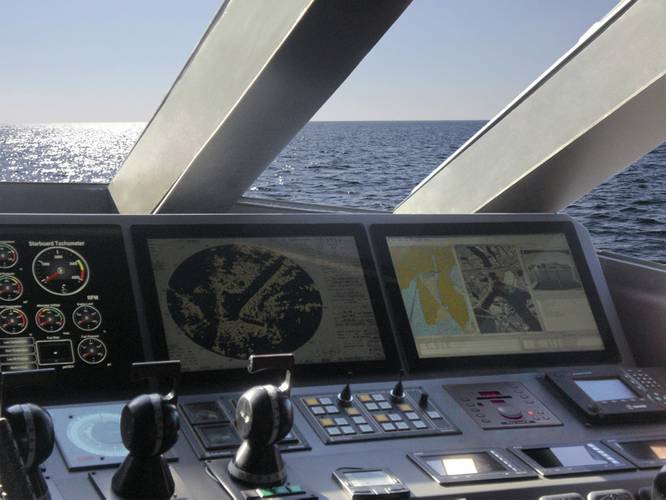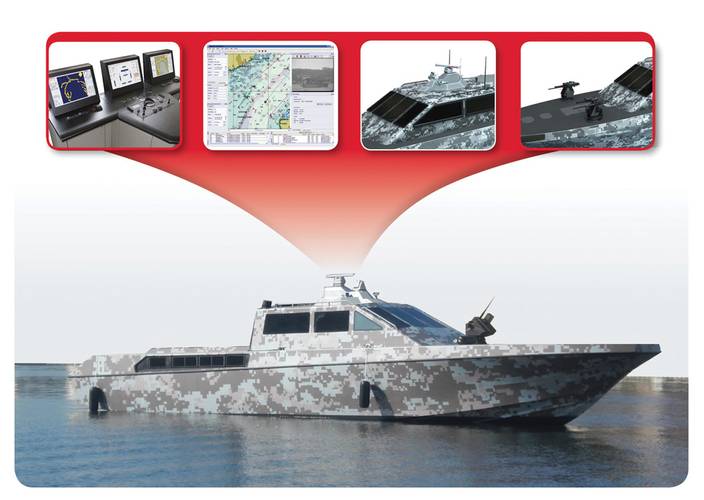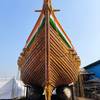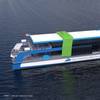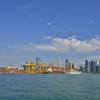Navy Tech in Paris Navy Technolgy Takes Center Stage
Many commercial marine products evolve from military roots. At Euronaval last month in Paris, contractors large and small from around the globe showcased new and emerging technologies.
According to General Electric, there is a new era dawning for naval engineering and propulsion. “I’ve seen the future of naval propulsion, and it’s electrifying,” said GE Power Conversion’s Captain Mark Dannatt Royal Navy (retd.), speaking at Euronaval.
Capt. Dannatt’s comments came as he outlined the latest advances in advanced naval electrical technology from a GE perspective. The world’s navies are not exempt from these operational, financial and environmental imperatives—in fact, they often are more exposed to the scrutiny of politicians, taxpayers and an environmentally aware public than some of their commercial counterparts.
Against this background, Captain Dannatt believes that we have entered the age of electrically powered and propelled warships and support vessels. “It’s increasingly common for naval ship designers to be directed to give increased weighting to through life costs of naval ships including fuel consumption and routine maintenance costs based on their selected power and propulsion options,” said Dannatt. “These studies often conclude that some form of electrical propulsion is worthy of further investigation based not only on fuel and maintenance costs but also on the consequential impact on improvements in ship availability and extended operational autonomy.”
GE’s Power Conversion business provides complete power and propulsion system packages, including prime movers, power generation, electrical distribution and fixed or variable speed drives, including motors for propulsion, thrusters and specialist applications.
The company’s expertise in ship power and propulsion systems ranges from the manufacture and supply of power generation systems to integrated full electric propulsion systems and, increasingly, hybrid propulsion systems.
Synapsis Command Bridge
Raytheon Anschütz developed a solution for OPV’s, smaller Naval and Coast Guard vessels. In Paris, the Synapsis Command Bridge was launched as a combination of commercial-off-the-shelf navigation with Command & Control capabilities to a new, homogeneous bridge system. The Synapsis Command Bridge aims to provide a solution that not only includes the Synapsis Integrated Navigation capabilities but also transfers enhanced Command & Control (C2) capabilities from the Raytheon Anschütz’ SmartBlue surveillance system to a new sea-based application.
“The Command Bridge comes as a scalable ‘off-the-shelf’ solution which is standardized to save unnecessary non-recurring engineering costs while at the same time remaining flexible enough to accommodate different sensors and weapon systems appropriate for different missions,” said Thomas Lehmann, System Engineer, Raytheon Anschütz. “Smaller vessels such as OPV’s and Fast Attack Crafts without requirements for a dedicated combat information center can be easily equipped to handle a variety of threat scenarios and missions efficiently and effectively.”
The bridge system is equipped with multifunctional workstations that unify the radar, ECDIS, conning, and C2 to single service oriented applications with a standardized user look and feel for monitoring, control, data and alert management. Whereas the tasks of radar, ECDIS (or WECDIS), and conning display are essential for navigation and IMO compliance, the C2 including electro-optic sensor (EOS) and weapon control significantly enhance the capabilities of the new system solution.
The Synapsis Command Bridge also includes flexible interfaces for rapid integration of sensors to detect, track and identify contacts as a premise for military situational awareness and surveillance requirements. This helps to realize customer-specific solutions and to add, replace or remove individual sub-systems and components - such as small target trackers, 2D radars, ESMs or sonars – with changing operational needs.
A good example for the requirement of a Command Bridge is the SeaStriker 22, which was recently launched by shipbuilder RiverHawk Fast Sea Frames of Tampa / Florida. The SeaStriker 22 is a 22 meter fast patrol and interdiction craft designed to counter asymmetric threats and to support various littoral security missions such as anti-piracy, offshore and near-shore interdiction, protection of harbors and offshore structures, anti-smuggling operations, police duties as well as search and rescue tasks. Whereas the ships needs to cope with various, potential rapidly changing missions and also to interact with other afloat and airborne platforms, as well as C2 elements ashore, there is the need for an integrated bridge solution that takes limited bridge space and small crew size into account. The vessel is equipped with a first fully operational Command Bridge.
Finely Focused on Naval Ship Design
Rolls-Royce announced that it has broadened its capability in ship design with the establishment of a new team dedicated to the development of naval ship designs. The new team will aim to develop vessels for navies, coast guards and other maritime agencies, including variants of the Environship merchant ship concept, will leverage technologies from commercial Rolls-Royce ship designs and products, adapted and integrated for the specific requirements of naval operations. One of the Rolls-Royce designs includes a replenishment ship for refueling and supplying naval fleets and is available in the 9,000 to 25,000 dwt range. The design is based on the Rolls-Royce Environship concept, featuring a wave piercing bow and hybrid electric propulsion system which increases operation efficiency while reducing fuel consumption. The design team will focus on offshore patrol vessels (OPVs), survey ships and support vessels, rather than combatant ships such as frigates and destroyers.
In a separate but equally relevant announcement, the company said it will develop a new mini waterjet designed to propel unmanned surface craft for the US Navy. The new water jet will be the smallest Rolls-Royce design to date, with a diameter of just 100 mm, and will be designed to quietly propel the craft through the water on remotely controlled missions that include intelligence, surveillance, and reconnaissance. Rolls-Royce will develop the water jet part of the innovative small propulsion system, part of a US Government funded Small Business Innovative Research (SBIR) project led by Candent Technologies Inc.
“Unmanned craft are a fast growing and exciting part of naval marine technology and we’re delighted to be working with Candent and the US Navy in developing this groundbreaking propulsion system,” said Dennis Duke, Rolls-Royce, Advanced Programs Director - Naval Marine Inc. “We are developing and adapting our world-leading water jet technologies as part of a highly efficient propulsion system which will enable these advanced craft to go about their duties criss-crossing waterways and oceans, often for months at a time.”
Known as MUSCL, the US Navy’s Modular Unmanned Surface Craft Littoral, is an X class unmanned surface vessel, designed to reduce risk to manned forces and perform tedious and repetitive surveillance tasks. The water jets will provide thrust to move the craft at speeds in excess of 25 knots as well as sustaining a cruise speed of 15 knots.
Production on New Finnish OPV
Late last month STX Finland Oy’s Rauma Shipyard started the production of next generation offshore patrol vessel to be built for the Finnish Border Guard. The start of production at the Rauma Shipyard was carried out following traditions. Chief of the Finnish Border Guard, Lieutenant General Jaakko Kaukanen pressed the launch button. The event held in the steel construction hall was witnessed by the representatives of the Finnish Border Guard, the Finnish Environment Institute, STX Finland and the classification society Germanisher Lloyd. In addition to border safety and frontier supervision missions, the offshore patrol vessel, scheduled for delivery in November 2013, can be used for search and rescue, military national defense and various underwater assignments both independently and in collaboration with other authorities. The ship will also feature substantial oil recovery capacity with important meaning for maritime oil recovery capabilities of Finland and the Baltic Sea region. The vessel measures 96 x 17 m and incorporates the latest technologies and environmentally friendly innovations in accordance with the Government decision-in-principle on sustainable public procurement. The ship is equipped with machinery using liquefied natural gas (LNG) and diesel as fuel.
(As publsihed in the November 2012 edition of Maritime Reporter - www.marinelink.com)







